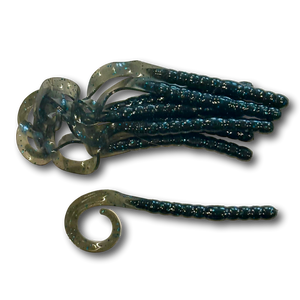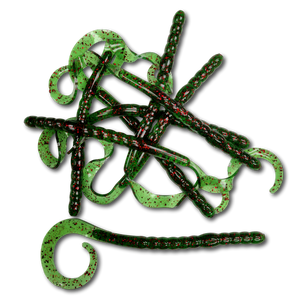Ribbon tail worms are long, soft plastic baits featuring a tapered body and a curled tail that creates movement with even the slightest retrieve. The tail’s fluttering action mimics the movements of a swimming baitfish or eel, making it a perfect imitation for hungry bass. These baits excel in warm water conditions and can be fished effectively in a variety of presentations.
What sets ribbon tail worms apart is their ability to move water and maintain action, even during slow retrieves. This makes them an excellent choice for targeting lethargic bass in both shallow and deep water.
Ribbon tail worms are versatile and can be rigged in numerous ways to suit different depths, water conditions, and fish behavior.
Texas Rigging is one of the most popular ways to fish ribbon tail worms. This weedless setup allows you to pitch or flip the bait into heavy cover like grass mats, brush piles, or submerged timber. The tail’s action as the worm falls and glides through cover often triggers aggressive strikes.
For deeper water, the Carolina Rig is an excellent choice. This rig keeps the ribbon tail worm near the bottom while allowing the tail to move naturally with the current. It’s a great way to cover water and target bass on ledges, points, or humps.
Weightless Rigging works particularly well in shallow water or around vegetation. Without the added weight, the ribbon tail worm falls slowly and naturally, making it an ideal presentation for finicky or pressured fish.
Ribbon tail worms can also be fished on a shaky head, especially in rocky areas or around docks. The tail’s natural undulation creates movement even when the bait is stationary, enticing strikes from curious bass.
For a more active approach, try swimming the worm. Retrieve it steadily through the water column, allowing the tail to create a subtle swimming motion. This method works well near weed edges, over submerged grass beds, or along rocky banks.
Ribbon tail worms are most effective during warm months when bass are more active and willing to chase larger baits.
- Spring: During the pre-spawn and spawn, ribbon tail worms fished on a Texas or Carolina rig are highly effective around shallow cover or bedding areas. The slow, natural movement can provoke territorial strikes.
- Summer: As water temperatures rise, bass often move to deeper structure. Ribbon tail worms excel when dragged along drop-offs, ledges, or submerged brush piles. Use a Carolina rig to maintain bottom contact and cover more water.
- Fall: Ribbon tail worms are perfect for targeting bass feeding heavily before winter. Cast along shallow flats, riprap, or grass lines, and retrieve the worm steadily to mimic a fleeing baitfish.
- Winter: While ribbon tail worms are less common in winter, downsizing and fishing them slowly on a Texas or shaky head rig can still produce bites, especially in deeper water.
These baits perform exceptionally well in lakes, reservoirs, and rivers with a variety of cover types, including vegetation, rock piles, and submerged timber.
Best Colors and Sizes for Ribbon Tail Worms
Color selection for ribbon tail worms depends on water clarity and light conditions.
- In clear water, natural colors like watermelon, green pumpkin, or translucent shades with subtle flakes are ideal.
- In stained or murky water, bolder colors like junebug, black and blue, or plum can help fish locate your bait.
- During low-light conditions or night fishing, darker colors create a strong silhouette that stands out to bass.
Ribbon tail worms come in a range of sizes, typically from 6 to 12 inches. Smaller worms (6-7 inches) are better for finesse presentations or when targeting finicky fish, while larger worms (10-12 inches) are perfect for summer and fall when bass are feeding aggressively and willing to chase larger prey.
Why Ribbon Tail Worms Are So Effective
Ribbon tail worms excel because they combine subtle movement with the ability to move water, creating an irresistible presentation for bass. The long tail undulates naturally during the retrieve, mimicking prey in a way that triggers both feeding and reaction strikes.
The versatility of ribbon tail worms makes them effective in a wide range of situations, from shallow water flipping to deep structure fishing. Their soft plastic material provides a lifelike feel that encourages fish to hold on longer, giving anglers more time to set the hook.
Tips for Fishing Ribbon Tail Worms
When fishing ribbon tail worms, adjust your retrieve speed and technique to match the fish’s behavior. In warm water, a steady or hopping retrieve works well to mimic a swimming baitfish. In colder water, slow down and allow the worm to glide naturally along the bottom.
Use a medium-heavy rod and 10-20 lb fluorocarbon or braided line for most ribbon tail worm applications. The added sensitivity helps detect subtle bites, especially when fishing in deeper water.
Experiment with weights to fine-tune your presentation. Lighter weights create a slower fall, ideal for shallow water, while heavier weights help maintain bottom contact in deeper areas.
Ribbon tail worms are a classic choice for anglers targeting bass in a variety of conditions. Their lifelike action, versatile rigging options, and ability to trigger strikes from both active and lethargic fish make them a staple in any tackle box. Whether you’re flipping heavy cover, dragging deep structure, or swimming the bait through grass lines, ribbon tail worms are a proven winner. Stock up on your favorite colors and sizes, and let this timeless bait bring more bass to your line.
Qwik Catches!








